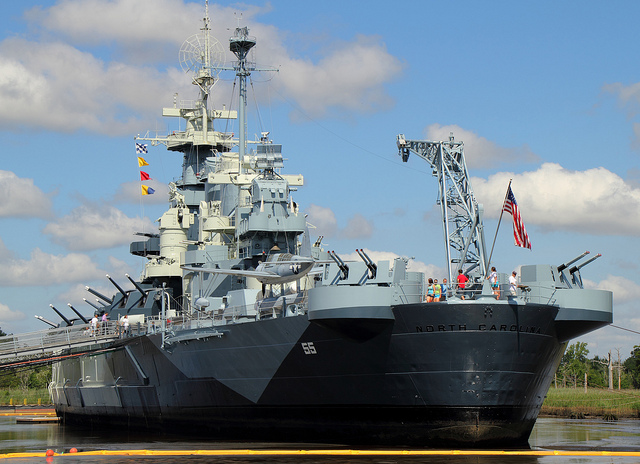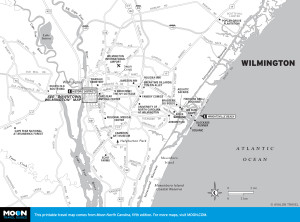
The USS North Carolina is one of several notable historic sights in Wilmington. Photo © Mr. T in DC, licensed Creative Commons Attribution No-Derivatives.

Wilmington
North of the city, about halfway between Wilmington and Topsail Island, is Poplar Grove Plantation (10200 U.S. 17 N., 910/686-9518, 9am-5pm Mon.-Sat., noon-5pm Sun., $10 adults, $9 seniors and military, $5 ages 6-15, $7 self-guided tour). This antebellum peanut plantation preserves the homestead of a successful farming family, including the beautiful main house, a restored tenant farmer’s cabin, a blacksmith’s shop, and a barn. A 67-acre nature preserve with an extensive network of hiking trails winds through coastal forests and wetlands, and a Farmers Market (8am-1pm Wed. Apr.-Nov.) shows off the bounty of the area’s agriculture.In Wilmington and the surrounding area are a number of significant military sites, most dating to the Revolutionary War and the Civil War. About 20 miles northwest of Wilmington, outside the town of Currie, near Burgaw, is the Moore’s Creek National Battlefield (40 Patriots Hall Dr., Currie, 910/283-5591, 9am-5pm daily, closed Thanksgiving, Dec. 25, and Jan. 1). The site commemorates the brief but bloody battle of February 1776 between Loyalist Scottish highlanders, kilted and piping and brandishing broadswords, and Patriot colonists. The Patriots fired on the Scotsmen with cannons and muskets as they crossed a bridge over Moore’s Creek. Some 30 Loyalists died in the attack, and the remainder scattered into the surrounding swamps and woods. The battle marked an important moment in the Revolutionary War, as the Scottish Loyalists were unable to join General Cornwallis’s army in Southport and mount an attack on Patriots nearby. It also marks an important moment in Scottish military history, as the battle was the last major broadsword charge in Scottish history, led by the last Scottish clan army.
Don’t be alarmed if you notice a battleship across the Cape Fear River from Wilmington; it’s the USS North Carolina (1 Battleship Rd., Eagles Island, 910/251-5797, 8am-8pm daily late May-early Sept., 8am-5pm daily early Sept.-late May, $12 adults, $10 seniors and active or retired military, $6 ages 6-11, free under 5), a decommissioned World War II warship that now serves as a museum and memorial to North Carolinians who died in World War II. This hulking gray colossus participated in every major naval offensive in the Pacific, earning 15 battle stars, and was falsely reported to have sunk six times.
Tours are self-guided and start with a short film providing an overview of the museum, then proceed onto the one-acre deck of the battleship. Nine levels of the battleship are open to explore, including the 16-inch gun turrets on the deck, the bridge, crew quarters, ship’s hospital, kitchens, and the magazine, where munitions were stored. It gets tight belowdecks and stairways are quite steep, so visitors prone to claustrophobia and those unable to traverse steep steps may want to stay topside.
The hallways and quarters below are dark, narrow, and surprisingly deep; from the heart of the ship, it takes more than a few minutes to find your way back to the deck. Crowds can make this more constricting, but nothing like it would have been in the balmy Pacific with 2,000 sailors aboard.
The USS North Carolina is also one of North Carolina’s most famous haunted houses—reputedly home to several ghosts, seen and heard by staff and visitors alike. The SyFy Channel has featured the ship on various ghost-hunting and paranormal shows, and it has been the subject of extensive investigations. Check out Haunted NC to hear some chilling and unexplained voices recorded by investigators.
By the mid-19th century, Wilmington was experiencing growing pains as the bustling shipping and railroad center of North Carolina. The city’s old cemeteries were becoming overcrowded with former residents, and Oakdale Cemetery (520 N. 15th St., 910/762-5682, 8am-5pm daily year-round) was founded some distance from downtown to ease the graveyard congestion. Designed in the parklike style of graveyards popular at the time, it was soon filled with superb examples of funerary art—weeping angels, obelisks, willow trees—set off against the natural beauty of the place. Separate sections were reserved for Jewish burials and for victims of the 1862 yellow fever epidemic. Oakdale’s website has an interesting guide to Victorian grave art symbolism.
Excerpted from the Fifth Edition of Moon North Carolina.